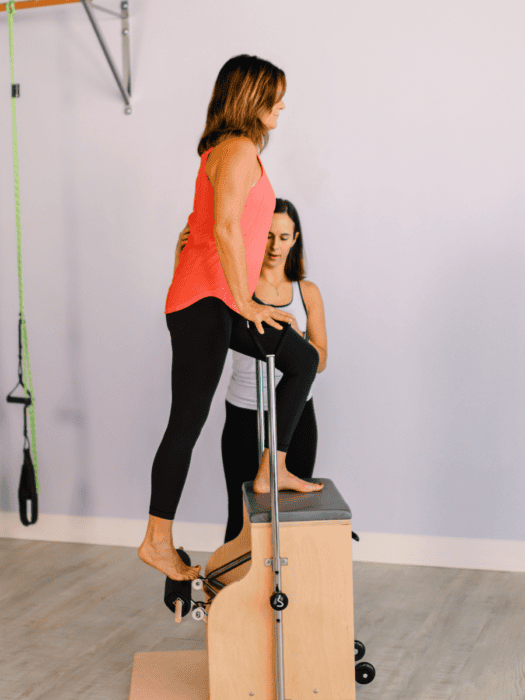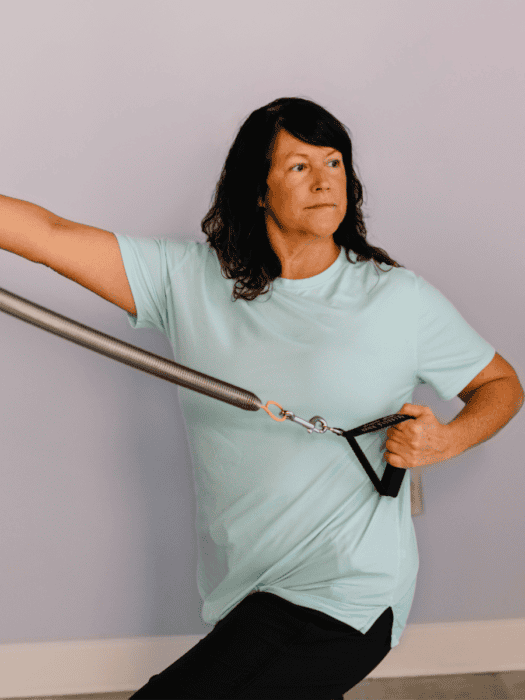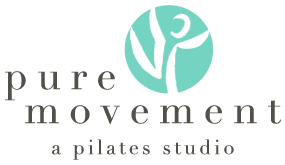Functional movements are any movement the body does as part of daily activities. They’re how we function in life. Exercising and working out mimics real-life activities such as picking something up, squatting down to get on the ground or sitting in a chair, climbing steps, and much more. Although the Pilates method may not look relatable to your day-to-day movements, it is functional movement that matters!
Plus, the Pilates method layers in neuro-programming as a mindful movement, breathing to strengthen core musculature, and complex multi-planar, multi-joint exercises to help in real-world situations when your body needs to take over and do it! Think of catching yourself as you fall.
Functional movement involves challenging the body through exercises that mimic real-life activities and it matters if you want to continue doing activities with those types of movement without pain, fear, or possible injury.
Functional Moves That Matter
Climbing

Squatting

Carrying

Climbing, whether within your house or stepping onto the curb. It is a functional movement that enables us to walk to the mailbox, take the stairs instead of the elevator, walk through the grocery store, step outside to get fresh air, run to catch a plane, and hike the world. Pilates exercises like Standing Leg Pumps, Lunges, Frogs, and Mountain Climbers mimic and strengthen your ability to do these real-life activities.
Squatting is a fundamental activity that involves picking something up off the floor, getting in and out of the car, or sitting on the toilet. It involves hinging at the hips and bending the knees while keeping the back straight without falling forward. Squat exercises like Footwork, Feet-in-Straps, Knee Stretch, Standing, and Mermaid help keep the hips fluid and mobile so you can keep getting up and down!
Lugging a heavy suitcase, carrying a grocery bag while you walk, or holding a child or grandchild on a hip is a typical daily activity that requires multiple muscle groups to coordinate. Carrying is a functional movement that engages balance, core strength, and grip. Plus endurance, especially when it comes to how long you may hold that something. Pilates exercises like Serve A Tray, Roll Down, Pull Downs, and Supine Arms build a stronger shoulder-trunk integration for carrying a load in a controlled movement pattern.
GET MOVING
Schedule an Intro
Pushing

Pulling

Pushing yourself up from a chair, pushing open doors, pushing a grocery cart or stroller all engage the chest, shoulders, and tricep muscles. Most importantly, as we age, our ability to push ourselves up off the floor gets harder. This is largely due to a weakened upper body and core connection. We always want to train the coordinated movement of our upper body with core activation. Pilates exercises like Swan, Rowing Front and Back, Standing Arms, and Chest Press strengthen the shoulders, triceps, and back extensors and teach proper shoulder stabilization to help prevent injury.
For those of us who sit at a desk for long periods of the day, pulling is a functional movement that matters significantly in everyday applications. Especially when it comes to pulling ourselves upright and into proper posture. The latissimus dorsi, trapezius, posterior deltoids, and biceps all contribute to pulling, which are our big upper body posture muscles. Exercises like Rowing, Pulling Straps, Swimming, Pull Downs, and Kneeling Abs Facing Back all counteract the forward hunched position, helping to pull the shoulders on the back and align the spine properly.
Why Functional Movement Matters The Take Away
Although not qualified as a type of Functional Training, the Pilates method lays a strong foundation for maintaining daily activities throughout life. The principles of Pilates parallel how functional movement training is used in exercise and why it matters. Both look at groups of muscles versus a single flex like Leg Day. They focus on balanced muscle development and coordinated movements over appearance or peak performance. Also, they assess and reassess the body and are not a one-size-fits-all approach. Promoting mindful movement to be safe, moving with specificity and control, and combining breathing, rhythm, and relaxation to improve your overall fitness.
Styles of movement, like Pilates, matter as functional exercise options because they teach the body to move as a whole rather than in parts. We all want to live pain-free and maximize our time and efficiency when exercising to keep doing what we love.
Disclaimer
THE INFORMATION EXPRESSED ON THIS SITE IS FOR EDUCATIONAL PURPOSES ONLY. WE DRAW ON OUR EXPERTISE AS PILATES AND MOVEMENT SPECIALISTS BY EXPANDING OUR PROFESSIONALISM THROUGH CONTINUING EDUCATION AND PERSONAL EXPERIENCES. WE AIM TO PROVIDE VALUABLE INFORMATION CONCERNING, BUT NOT LIMITED TO, PILATES, FUNCTIONAL MOVEMENT, AND FITNESS. YOU TAKE FULL RESPONSIBILITY FOR ALL DECISIONS NOW OR IN THE FUTURE CONCERNING YOUR HEALTH, LIFE, AND WELL-BEING. THIS INFORMATION IS NOT TO BE USED AS MEDICAL ADVICE EITHER TO DIAGNOSE, TREAT, CURE, OR PREVENT ANY DISEASE OR AILMENTS. YOU SHOULD CONSULT A PHYSICIAN BEFORE BEGINNING ANY EXERCISE PROGRAM.
